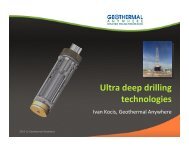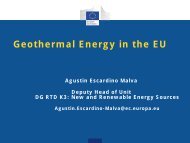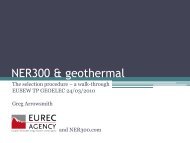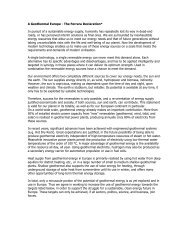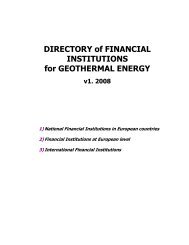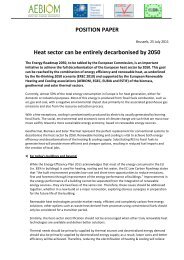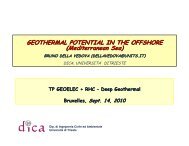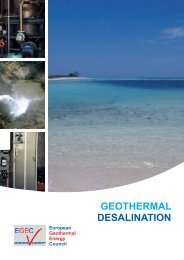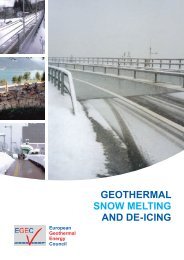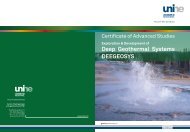Strategic Research and Innovation Agenda for Renewable ... - EGEC
Strategic Research and Innovation Agenda for Renewable ... - EGEC
Strategic Research and Innovation Agenda for Renewable ... - EGEC
Create successful ePaper yourself
Turn your PDF publications into a flip-book with our unique Google optimized e-Paper software.
5<strong>Strategic</strong> <strong>Research</strong> <strong>and</strong> <strong>Innovation</strong> <strong>Agenda</strong> <strong>for</strong> <strong>Renewable</strong> Heating & CoolingRHC applications to industrial processes5.3.1 <strong>Research</strong> <strong>and</strong> innovation priorities with impact in the Short TermR&D activities on biomass technology <strong>for</strong> industrial heating <strong>and</strong> cooling should focus onimproving efficiency of large-scale plants <strong>and</strong> decreasing their carbon footprint. Taking intoaccount the increasing emissions st<strong>and</strong>ards <strong>and</strong> the limited availability of high quality woodresources in Europe, significant R&D ef<strong>for</strong>ts are required to develop high-efficient loadflexiblemulti-fuel systems. Fuel supply will become a crucial issue <strong>and</strong> R&D activities shouldthere<strong>for</strong>e always consider the chain integration.Tri-generation with biomass presents various advantages which make it an interestingsolution in different energy systems. Biomass is storable renewable energy <strong>and</strong> can be used<strong>for</strong> regulating electricity production. Moreover, biomass can be used <strong>for</strong> heating, cooling <strong>and</strong>electricity production with system efficiency of up to 85%.BIO.9ObjectiveDevelopment of highly efficient large-scale or industrial CHP with enhancedavailability <strong>and</strong> high temperature heat potentialThe aim of this priority is to increase the steam data, i.e. pressure <strong>and</strong> temperature(advanced steam data), from 540°C to 600°C <strong>for</strong> 100% biomass-fired plants. Biomass<strong>and</strong>/or biomass co-firing power plants should increasingly utilise waste heat <strong>for</strong> industrialheat utilisation. Alternative technology options, e.g. biomass gasification <strong>and</strong> indirect co-firing,should be investigated. Process adaptations of fuel pretreatment are required, e.g. torrefactionto reduce alkaline content of biomass <strong>and</strong> improve grindability 60 . Corrosion, fouling <strong>and</strong> agglomeration(in Fluidised Beds (FBs)) from alkali metal chlorides <strong>and</strong> heavy metals (Pb, Zn, etc)in biomass-fired plants <strong>and</strong> co-firing units should be reduced by:• R&D of new materials (austenitic alloys, Ferritic alloys, FeCrAl alloys, Ceramics) suitable<strong>for</strong> combustion of problematic biomass types, tackling problems such as creeping, cracking,Thermal Mechanical Fatigue (TMF) , corrosion, erosion, fouling;• Development <strong>and</strong> testing of new additives that result in the <strong>for</strong>mation of less corrosivesubstances: (i) sulphur containing additives: ammonium sulphate, elemental sulphur, sulfurgranules, (ii) phosphorous containing additives: dicalcium phosphate, monocalium phosphate<strong>and</strong> (iii) AlSi containing additives: kaolin, dolomite, bentonite;• Development <strong>and</strong> testing of suitable co-firing matrices <strong>for</strong> problematic biomass fuels,e.g. co-firing high alkali metal-containing biomass with high sulphur fuels;• Demonstration of new types of boiler design that minimize fouling/corrosion in critical areas,e.g. changes of excess oxygen, flue gas temperature <strong>and</strong> velocities.State-of-the-art CHP units fuelled with biomass only currently reach a net electrical efficiency around 30%<strong>and</strong> this per<strong>for</strong>mance is increased to over 43% <strong>for</strong> co-firing plants. Steam temperature amountto 540°C <strong>for</strong> clean biomass. Thermal shares of agrobiomass <strong>and</strong>/or RDF are limited to 20%<strong>and</strong> in most cases do not exceed 10%. The majority of large-scale plants produce power only,the heat is wasted.TargetsType of activity• Demonstration of a highly efficient (>40 %) steam CHP-plant <strong>for</strong> clean fuel fractionswith enhanced steam parameters (up to 600°C );• Demonstration of a high efficient steam (34%) CHP-plant <strong>for</strong> broader fuel span with enhancedsteam parameters (up to 540°C );• Demonstration of a high efficiency biomass <strong>and</strong>/or co-firing power plant with an agrobiomass<strong>and</strong>/or RDF thermal share of 30%;• Total CAPEX <strong>and</strong> OPEX increase of no more than 5-10% over current state of the art <strong>for</strong>new technologies;• 1-2 demonstrations of power plants producing only electricity converted to CHP units<strong>for</strong> provision of industrial heat;30% Development / 70% Demonstration5.3.2 <strong>Research</strong> <strong>and</strong> innovation priorities with impact in the Medium <strong>and</strong> Long TermBIO.10ObjectiveDevelopment of high efficient biomass conversion systems <strong>for</strong> tri-generation(heating, cooling <strong>and</strong> power)In this R&D priority the main mission is to analyse <strong>and</strong> identify the role of biomass as a“storable RES” within a 100% renewable energy system, particularly in combination withintermittent RES such as solar <strong>and</strong> wind.The new tri-generation operating environment requires new, simultaneous functions <strong>and</strong>capabilities from the biomass CHP-C units: flexible load operation, fuel flexibility as well asoperation in integration with energy storages. Specific technologies to increase the intelligenceof multi-fuel units must be identified <strong>and</strong> developed including on-line fuel quality <strong>and</strong> processmonitoring; as well as introducing fertiliser factories in order to fully recycle the ash-boundbiomass nutrients back to the fields <strong>and</strong> <strong>for</strong>ests.The system analysis requires the development of dynamic models that can simulate the daily<strong>and</strong> seasonal behaviour of urban energy system in different climatic conditions. Dependingupon the season, climatic condition <strong>and</strong> time of day the primary function of such biomass fuelledunits may change from electricity, heating, cooling to even bio-oil production (<strong>for</strong> example withintegrated pyrolysis oil production).60Higher Hardgrove GrindabilityIndex (HGI) in order to makebiomass ‘coal mill ready’. TheHGI was developed as anempirical test to indicate howdifficult it would be to grind aspecific coal to the particlesize necessary <strong>for</strong> effectivecombustion in a pulverizedcoal fired boiler. It can alsobe used <strong>for</strong> torrefied biomass.54



